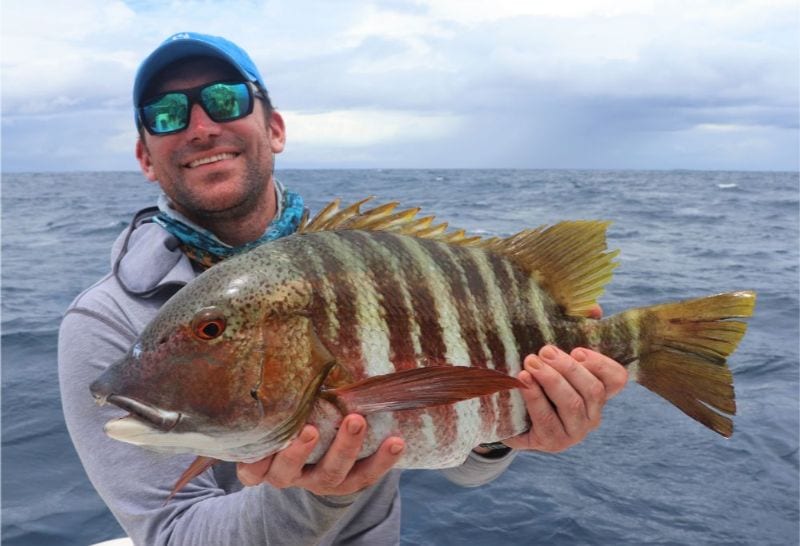When the Spaniards first arrived here in the early 1500’s, they named the country “Panama” from the native Kuna Indian language’s word for “Abundance of Fish” or “Place of Many Fish”. And we would definitely have to agree! There are over 50 species of game fish to be caught here, and over 250 IGFA World Records have been set in Panamanian waters!
Other than the Marlin, Yellowfin Tuna, and Roosterfish that we already featured…a few of our more frequently caught types of fish species here at our lodge are:
Cubera Snapper
The Cubera Snapper is one of the most impressive species to catch. They are the largest of the snapper species in the world and reach up to about 70 pounds here in Panama. They are a mean prehistoric looking fish with a huge disproportionate head and large reddish orange scales. They also have a mouth full of monster canine like teeth that make them look even meaner…so much so that the locals have given them the name ‘Dienton’ or ‘big teeth’. We catch Cuberas in shallow water less than 200 feet inshore near islands and submerged rocks. Most are caught on live bait or chunks of dead bait but occasionally are caught on poppers or swim baits near the surface. When you do hook a Cubera Snapper watch out because they are know to strike hard and fight like hell! They almost always make a long hard initial run and take off straight for the bottom to try and break you off in the rocks. They are excellent to eat but because they are a slow growing and borderline endangered species we release all Cubera Snappers here at Sport Fish Panama Island Lodge.
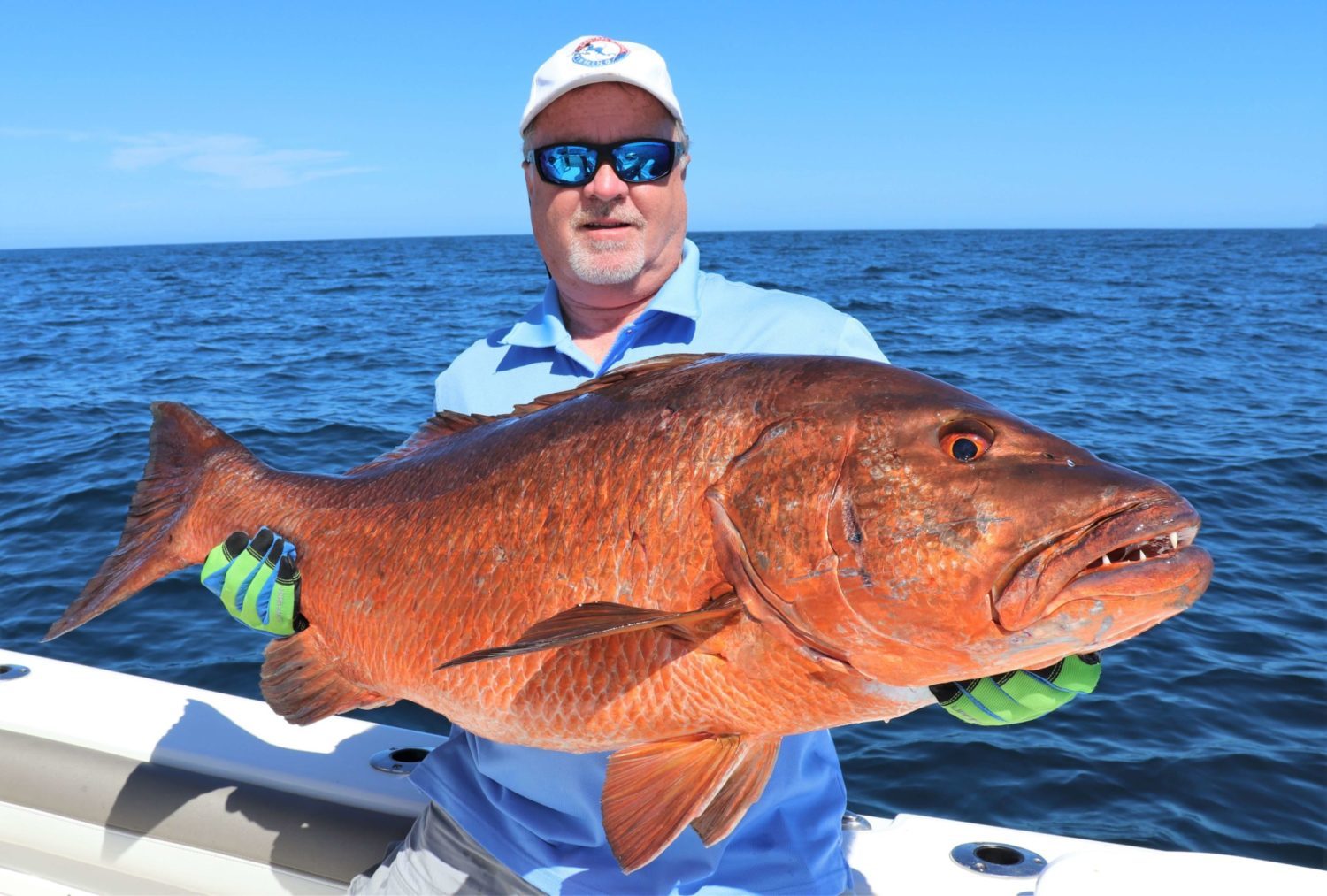
Mullet Snapper
Like their close cousin the Cubera…the Mullet Snapper looks similar with large reddish orange scales but has a slimmer body and smaller head. They are smaller generally in the 10 to 20 pound range but some are caught here up to 30 pounds. They also inhabit the same inland areas and submerged rocks in less than 200 feet as the Cuberas but tend to travel in larger schools and are even more aggressive. They are strong fighters that change direction often during a fight. We catch most of them on live bait, dead bait chunks, poppers, and jigs. Mullet Snapper is great to eat and plentiful here in Panama.
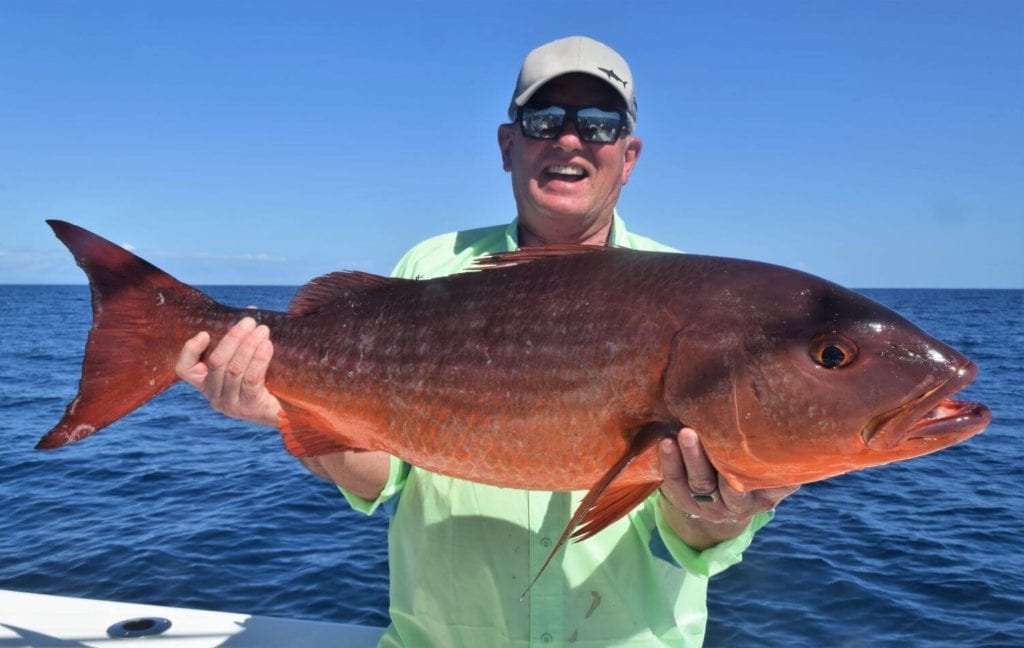
Mexican Barred Snapper
Another common catch here is the Mexican Barred Pargo or ‘Rocquero’. They look similar to a Sheepshead but have a very distinct copper reddish brown coloring with vertical white stripes on their bodies. They also have human looking teeth like the Sheepshead does. We catch them in the same areas, using the same techniques, as the snappers mentioned above but almost always are hooked when fishing right on the bottom. We also catch them often while jigging. We keep a few but release most of them as it’s one of the best eating fish here. If the meat is not cooked properly it can be tough.

Almaco Jack
The Almaco Jack or ‘Bohala’ is very similar looking to the traditionally more well known Amberjack but tends to have an olive coloring, more compact body, and a much longer second dorsal fin and anal fin. They sometimes are called ‘reef donkey’ because they pull hard! We tend to catch them in deeper water from 90 to 300 feet. Almacos are mostly caught on live baits and jigs but every now and then they will come up and strike a popper. They usually are in the 10 to 30 pound range but we have caught them up to 60 plus pounds. Good eating but we release most all of them.
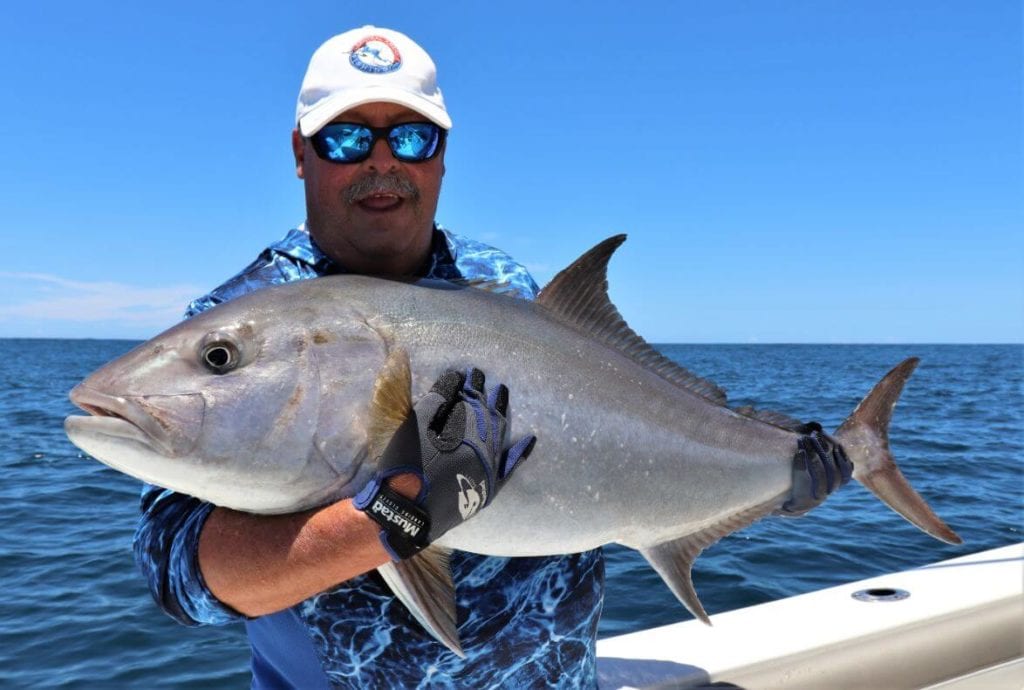
Jack Crevalle
The Jack Crevalle is considered a trash fish by most but it is hands down one of the most aggressive and hardest fighting fish in the ocean! These large white and yellow colored fish tend to travel in large voracious schools of fish from 5 to 40 pounds. We usually catch them inshore or near submerged rocks and they will attack almost anything you throw at them. Jack Crevalles hit poppers, swimbaits, and live baits hard! Not very good to eat.
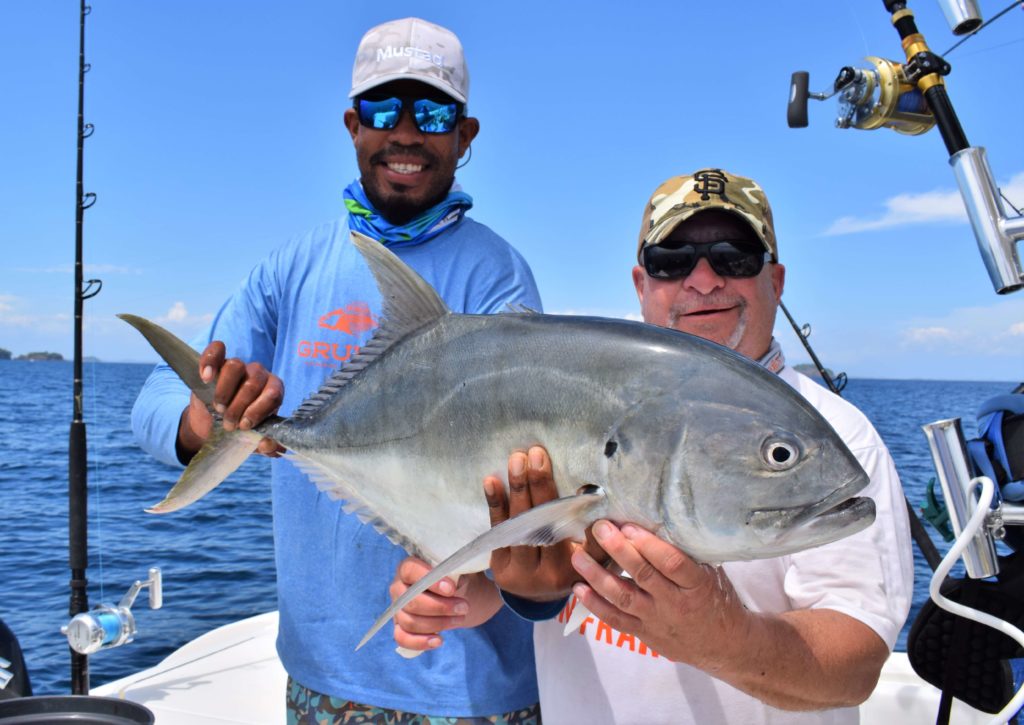
Horse-eye Jack
The Horse-eye Jack is similar to its cousin the Jack Crevalle but is grey colored and has a larger eye…hence its name. They tend to congregate in the same inshore areas and seamounts. They aren’t quite as common as the Jack Crevalle but they are great fighters! Not very good to eat.

Bluefin Trevally
The Bluefin Trevally is one of the most beautiful fish in the Jack family. They have silverfish/white compact body with electric blue spots and tail. They also fight very hard and will crush a live bait, popper, or swimbait while targeting inshore species. Unlike most other Jacks they are very good to eat but we release most all that we catch.
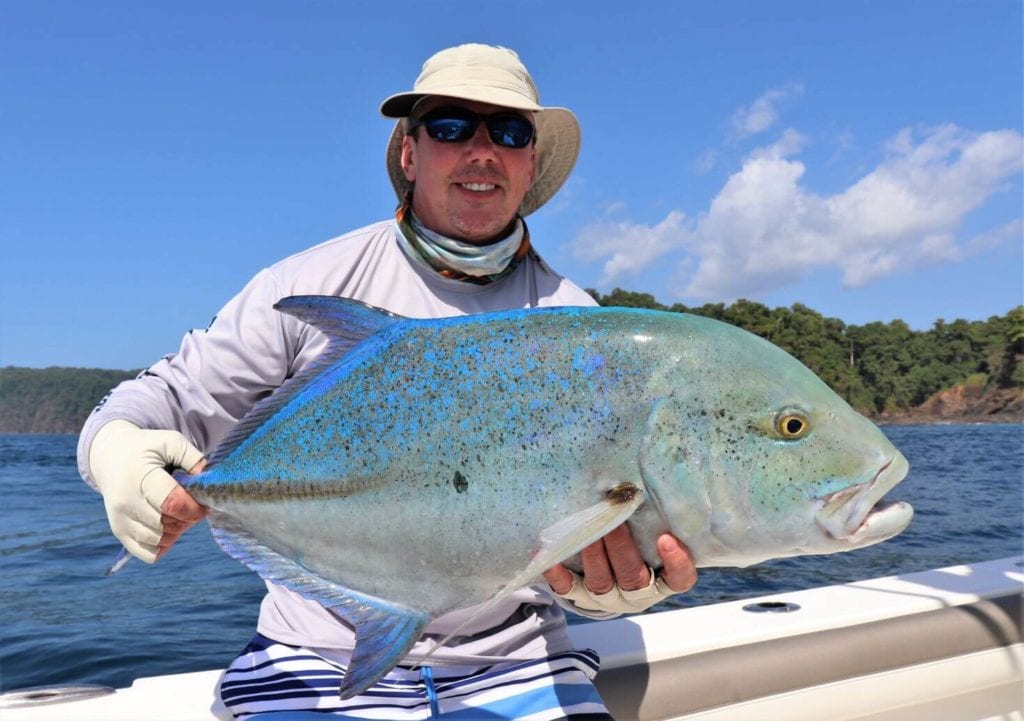
Rainbow Runner
The Rainbow Runner is another fish in the Jack family that we run across often here in Panama. They look much different than the other Jacks mentioned. They have long roundish bodies, more similar to the Almaco Jack, but they have strikingly blue/green upper bodies that fade to white underneath with two narrow, light blue to bluish white stripes that run the length of the fish, with a broader olive to yellow stripe between them. We tend to find them offshore hanging on the pinnacles of seamounts in big schools and sometimes inshore. They are good fighters that are most always are caught on small live baits. The Rainbow Runner’s meat is very good and is prized for sushi and ceviche.
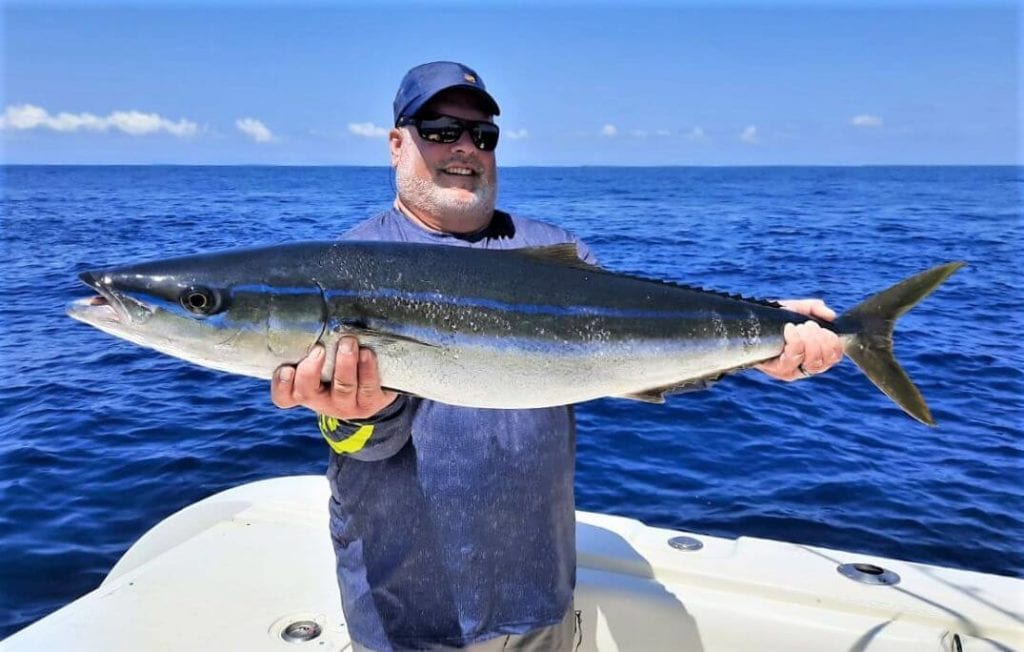
Wahoo
The Wahoo is in the Scombridae family same as the Tuna and Bonito but has a much longer grey colored body with zebra-like stripes. Wahoo are caught here year-round but we tend to get most of them during the rainy season months. They like to hang offshore in areas generally with lots of current around pinnacles of seamounts or near drop-offs of the sea floor. They are one of the fastest fish in the ocean and when they get hooked they almost always take a long hard run…so hold on! Wahoo is one of the best eating fish, and are here in numbers, so we like to keep them for dinner.
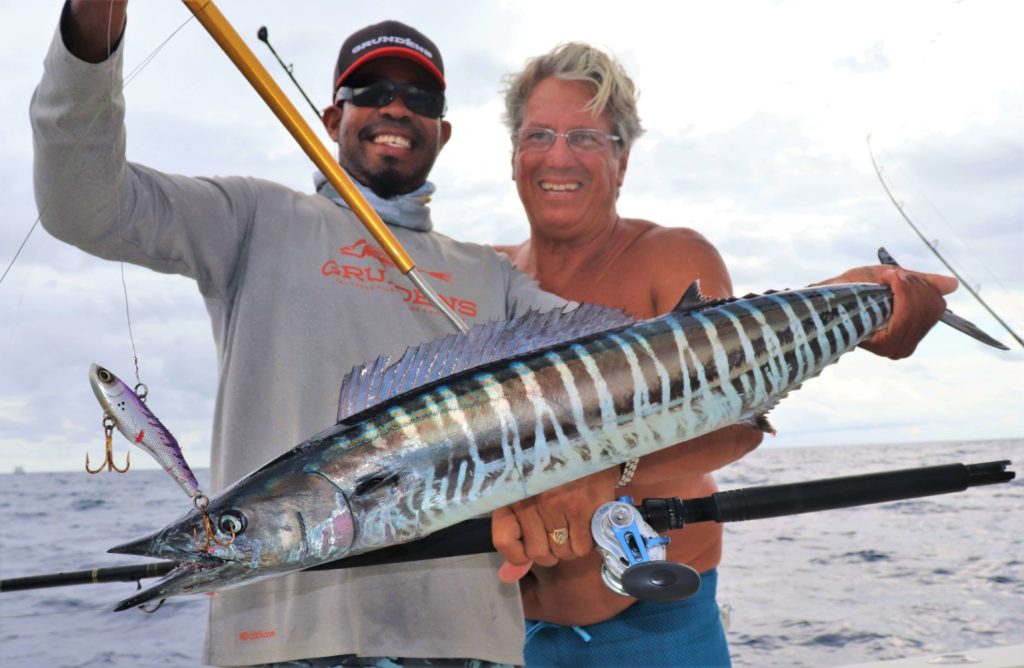
African Pompano
The African Pompano is another one of the very exotic prehistoric looking fish species we catch here when targeting inshore species. They have a metallic silver colored body, almost like a mirror, and their body shape is very distinct making them look almost like they are ‘armor-plated’. Also in the Jack family, they are aggressive and fight very hard. They are exceptionally good to eat!
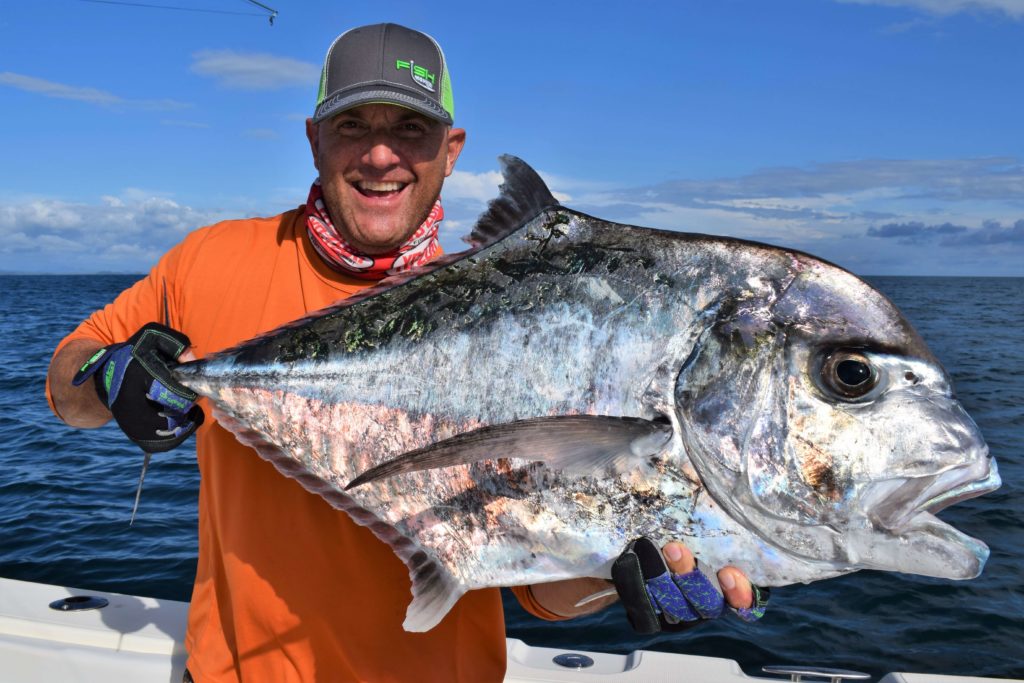
Pacific Snook
Only found inshore near the river mouths or in the estuary systems on the mainland or larger islands…the Pacific Snook or ‘Robalo’ is an aggressive inshore species that we always love to target! Not the most common catch for us here, as we tend to target more offshore and out island species, but we do have some go-to spots we can hit for them when the time is right. Almost always we find the Snook around large clouds of tiny baitfish that are being herded into the small bays around the many out islands here in the Gulf of Chiriqui or near river mouths. We cast small swimbaits into the areas either where we see the fish or where we see them chasing baitfish.
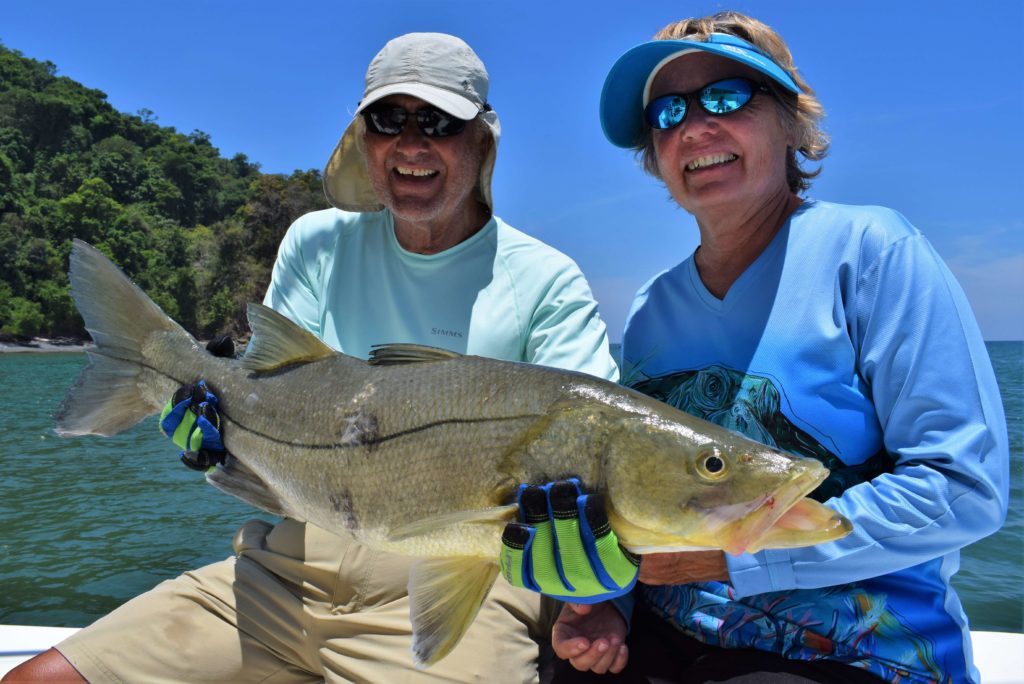
Sierra Mackerel
The Sierra Mackerel or Spanish Mackerel is common catch around the many islands and submerged rocks we have here in the Gulf of Chiriqui. We tend to catch them casting swimbaits when we are inshore targeting Roosterfish and Cubera Snapper. Sierras don’t get very big, usually up to 10 pounds, but tend to be very aggressive and will viciously strike a bait and then pull hard! They are not generally a species that sportfisherman intentionally target but the locals love to catch them as they are excellent eating!
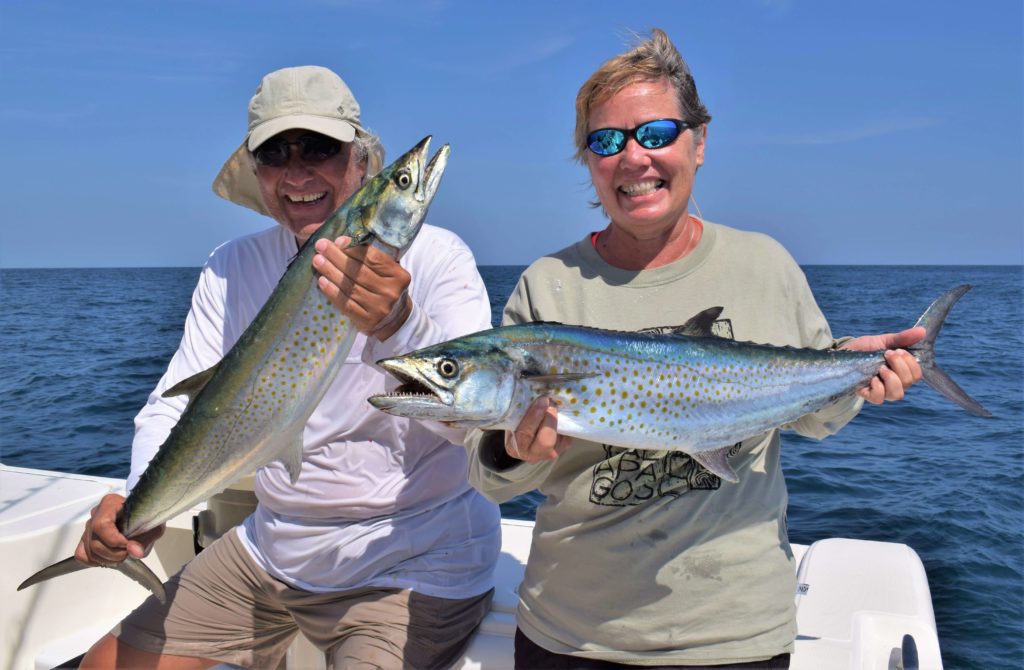
Pacific Sailfish
The Pacific Sailfish or ‘Pez Vela’ is one of the most beautiful exotic fish we find offshore here in Panama. We find them offshore in the same blue water when we’re targeting Marlin and Tuna. Many times, we’ll sight them tailing offshore and pitch a bait live bait at them to induce a strike. Other times, we’ll hook them using live bait as we are targeting Tunas in feeding frenzies offshore. They tend to be extremely aggressive and are great fighters on light tackle. They grow up to 200 plus pounds and are plentiful here in the waters of Panama.
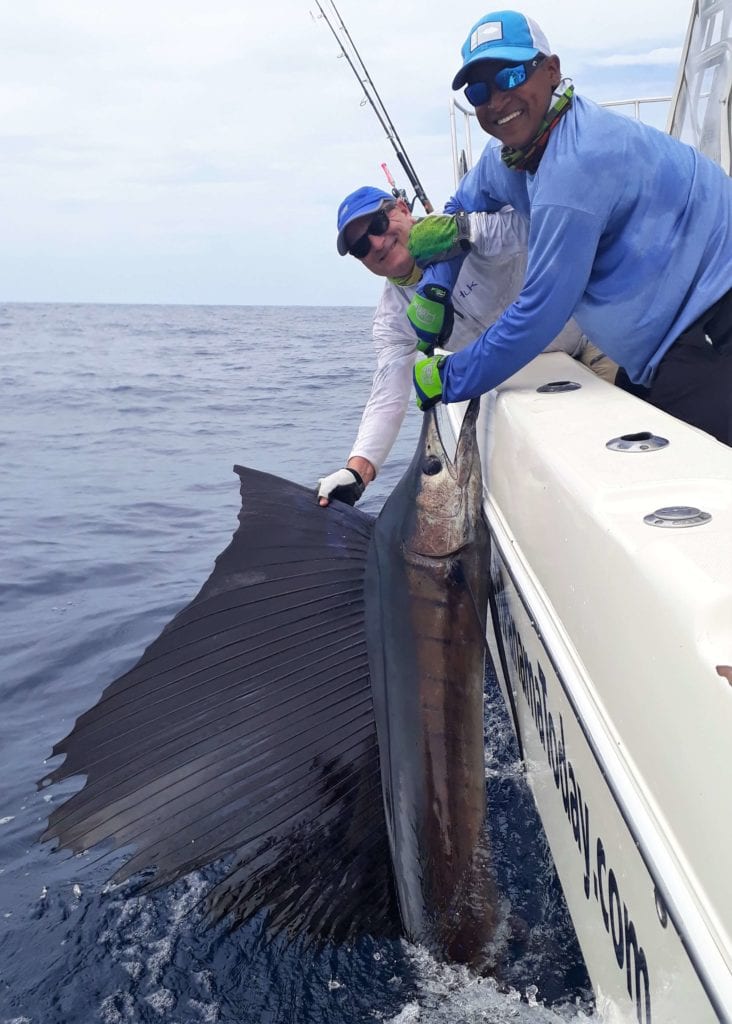
Dorado
Also known as ‘Mahi-Mahi’ or ‘Dolphin’ the Dorado is probably hands down the most beautiful fish in the ocean. Its bright yellow/gold colored body is speckled with spots of iridescent blue and green that distinguish it from any other fish. Very common year-round here most we catch are around 10-25 pounds but we occasionally get them 60 pounds or more. We tend to catch them offshore around floating debris and in areas with lots of bait around. They are super aggressive and will almost always immediately strike any bait you throw in front of them. Dorado is very good to eat and is also a very sustainable species as they grow very fast and are many of them around.
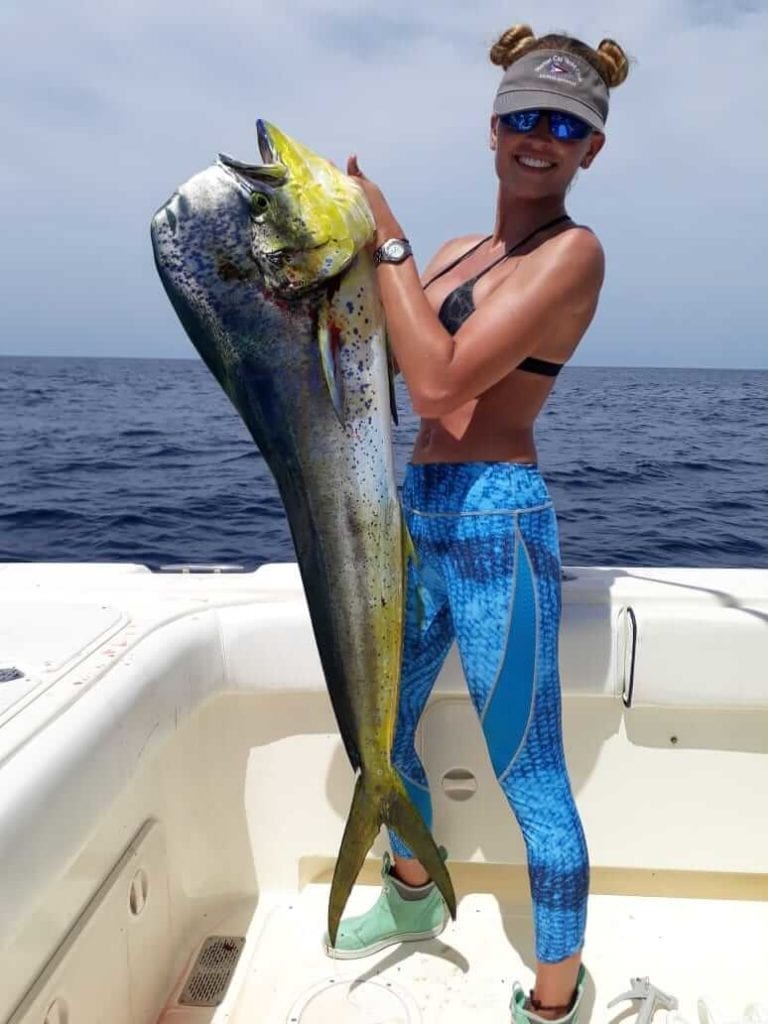
Panama Fishing Frequently Asked Questions:
We have a wide variety of species inshore and offshore here in the Gulf of Chiriqui to choose from. More than 20 different gamefish can be caught on any given day. We specialize in Yellowfin Tuna, Black and Blue Marlin, Pacific Sailfish, Cubera Snapper, Dorado, Almaco Jack, Wahoo, and Roosterfish.
We use a wide variety of fishing methods here and our Captains are well versed to do whatever it takes to get the fish to strike. We usually fish with live bait, cast poppers/lures, and fish dead bait. Often when those methods aren’t working, or the client prefers, we will troll plastics or dead ballyhoo.
We take pride here in conservation and release most of the fish we catch. All Marlin, Sailfish, Roosterfish, Cubera Snappers, will be relaeased after we take a photo.
No problem bringing fish back with you! We will fillet, vacuum seal in 3 mm 12′ x 12′ bags, and freeze a portion of your catch at a cost of $14/bag for you to take home. We recommend you bring a Yeti Hopper type tote bag or small 30-40 quart cooler. Or you can buy one of our coolers we have available for purchase here at the lodge for $70.
No fishing licenses are needed here in Panama.
Our lodge supplies all of the highest quality tackle you will need to catch every available species. We use only top quality reels from Accuate and Shimano. Top of the line rods from Blackfin, Accurate, and Temple Reef. We use only the best poppers, swim baits, braided line, and fluorocarbon leader from Yo-Zuri. And the highest grade hooks, swivels, and swiwel snaps from Mustad. If you want to bring along your favorite rod/reel and/or tackle lures you are more than welcome to put them to the test here with us!
We do it all here depending on the species and time of year we’re fishing. We mainly like to live bait for Marlin, Tuna, and other offshore species. We’ll bring Blue Runners with us and use Bonito that we’ll catch offshore, bridle them with large circle hooks, and slow troll them or drift them in fishy areas. If the live bait is not getting it done…we also quite often will troll the plastics and rigged Ballyhoo to get the fish. Also, quite often we will chunk dead sardines to target big Tunas as well as throw Poppers and Jigs…whatever it takes! When we turn our attention to the inshore fishing, like for Roosterfish and Cubera Snapper, we still like to use live bait but there is also a good opportunity to cast poppers and swim baits around the many island group’s rocky shorelines and submerged rocks.
How Can You Contact Us?
You can contact Captain Shane at [email protected]. Also, feel free to call us at 1-(866) 245-1492 for availability or more info!
 (866) 245-1492
(866) 245-1492 

